Click on images to enlarge
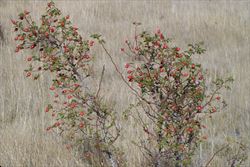
habit (Photo: Trevor James)

habit (Photo: Trevor James)
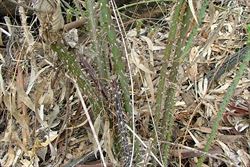
thorny older stems (Photo: Sheldon Navie)

close-up of thorns on smooth older stems (Photo: Sheldon Navie)
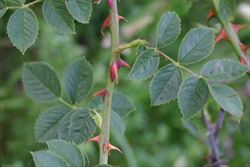
younger stem and once-compound leaves with five or seven leaflets (Photo: Trevor James)
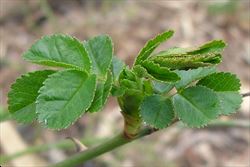
close-up of young leaves showing sticky hairs on the undersides of the leaflets (Photo: Sheldon Navie)

pink flowers (Photo: Greg Jordan)
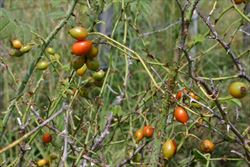
immature fruit (Photo: Trevor James)
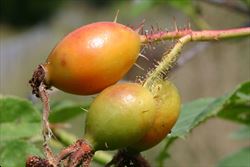
close-up of immature fruit with a few small spines near their bases and numerous bristly spines on their stalks (Photo: Trevor James)
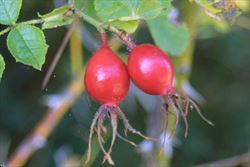
bright red mature fruit (Photo: Trevor James)
Scientific Name
Rosa rubiginosa L.
Synonyms
Rosa arabica Crep.Rosa eglanteria L.
Family
Rosaceae
Common Names
briar rose, eglantine, mosqueta rose, sweet briar, sweet briar rose, sweet brier, sweet brier rose, wild rose
Origin
Originated in Europe and western Asia (i.e. Eurasia).
Cultivation
Sweet briar (Rosa rubiginosa) is cultivated as a garden ornamental, particularly as a hedging plant in the temperate regions of Australia.
Naturalised Distribution
Widely naturalised in southern and eastern Australia (i.e. in the sub-coastal and inland districts of southern Queensland, in many parts of New South Wales and South Australia, in the ACT, in Victoria and Tasmania, and in the coastal districts of south-western Western Australia.
Habitat
This species is a weed in grasslands, bushland, open woodlands, roadsides, waste areas, gullies, riparian vegetation, hedgerows and pastures in temperate and cooler sub-tropical regions.
Habit
An upright (i.e. erect), or sometimes climbing (i.e. scandent), prickly shrub forming dense thickets. It usually grows 1.5-2 m tall, but sometimes reaches up to 3 m in height.
Distinguishing Features
- an upright, or sometimes climbing, prickly shrub forming dense thickets and growing 1-3 m tall.
- its stems are smooth, but armed with scattered prickles (10-15 mm long).
- its leaves are compound, with 5-7 leaflets that have sharply toothed margins.
- its sweetly-scented flowers (20-50 mm across) have five pink or white petals and are borne on stalks that are covered in sticky hairs.
- its fruit is an oval or egg-shaped fleshy capsule (15-20 mm long) that turns orange or red in colour as it matures.
- the fruit often have scattered bristles or small spines near their bases.
Stems and Leaves
The upright (i.e. erect) or arching stems are smooth and green or reddish in colour when young, but become rough and woody as they mature. They are armed with scattered, backward-curving (i.e. recurved), prickles of various sizes (10-15 mm long).
The alternately arranged leaves are compound (i.e. pinnate) with 5-7 (rarely nine) leaflets and a prickly stalk (i.e. petiole). The leaflets (10-40 mm long and 5-28 mm wide) are egg-shaped in outline (i.e. ovate) or broadly oval (i.e. elliptic) in shape and have sharply toothed (i.e. serrated) margins. There are also a pair of leafy bracts (i.e. stipules) present at the base of the leaf stalks (i.e. petioles) and the leaves have a few sticky (i.e. glandular) hairs on their undersides and along their margins.
Flowers and Fruit
The rather large flowers (20-50 mm across) are borne in loose clusters at the tips of the branches. They have five pink, pinkish-white or white petals (8-25 mm long), numerous stamens, and five narrow sepals that are often covered in sticky (i.e. glandular) hairs. These flowers are borne on stalks (i.e. peduncles) that are covered in sticky (i.e. glandular) hairs. Flowering occurs mostly during spring and early summer.
The fruit is an oval (i.e. ellipsoid) or egg-shaped (i.e. ovoid) flehy capsule (called a 'hip') that turns orange or red in colour as it matures. These capsules (15-20 mm long) usually have a few bristles or small spines near their base and are topped with the remains of the sepals. They contain numerous yellow seeds that are irregularly shaped (4-7 mm long).
Reproduction and Dispersal
This plant reproduces mostly by seed, but may also produce new shoots from its long-lived (i.e. perennial) rootstock.
Seeds are most commonly dispersed by birds and other animals (e.g. foxes) that eat the fruit. They may also be spread in water and dumped garden waste.
Environmental Impact
Sweet briar (Rosa rubiginosa) invades lowland grassland and grassy woodland, dry sclerophyll forest, damp sclerophyll forest, riparian vegetation, and alpine and sub-alpine vegetation in the temperate regions of Australia. It is regarded as a significant environmental weed in South Australia and the ACT, and as an environmental weed in Victoria, New South Wales, Queensland and Tasmania. It is actively managed by community groups in the ACT and South Australia and was recently listed as a priority environmental weed in four Natural Resource Management regions.
Legislation
This species is declared under legislation in the following states and territories:
- ACT: C2 - a pest plant that must be suppressed, and C4 - prohibited pest plant (a pest plant whose propagation and supply is prohibited).
- New South Wales: Class 4 - a locally controlled weed. The growth and spread of this species must be controlled according to the measures specified in a management plan published by the local control authority and the plant may not be sold, propagated or knowingly distributed (in numerous local authority areas). See the New South Wales Department of Primary Industries Noxious Weeds List at http://www.dpi.nsw.gov.au for more detailed information on which local areas are covered in these declarations.
- South Australia: 3* - declared in Class 3d, a designation for briars. This species is required to be controlled in part of the state only.
- Victoria: C9 - all reasonable steps must be taken to control this species and prevent its spread (in the Wimmera, Glenelg, Corangamite, Port Phillip West, Port Phillip East, Goulburn, North East, West Gippsland and East Gippsland regions).
- Western Australia: Unassessed - this species is declared in other states or territories and is prohibited until assessed via a weed risk assessment (throughout the entire state).
Management
For information on the management of this species see the following resources:
- the Victorian Department of Primary Industries Landcare Note on this species, which is available online at http://www.dpi.vic.gov.au.
- the Tasmanian Department of Primary Industries and Water Weed Service Sheet on this species, which is available online at http://www.dpiw.tas.gov.au.
Similar Species
Sweet briar (Rosa rubiginosa) may be confused with dog rose (Rosa canina) and Macartney rose (Rosa bracteata). These species can be distinguished by the following differences:
- sweet briar (Rosa rubiginosa) has flower stalks and sepals with sticky (i.e. glandular) hairs or spines. Its leaves have sticky (i.e. glandular) hairs on their undersides, and along their margins, and the leaflets have almost rounded tips. Its flowers are pink or white in colour and the bases of its fruit are sometimes adorned with bristles and/or small spines.
- dog rose (Rosa canina) has hairless (i.e. glabrous) flower stalks and sepals. Its leaves are mostly hairless with leaflets that have pointed tips. Its flowers are pale pink to bright pink in colour and its fruit are hairless (i.e. glabrous) and unadorned, except for the remains of the sepals.
- Macartney rose (Rosa bracteata) has flower stalks and sepals that are densely covered with hairs or spines. Its leaves are mostly hairless, except for a few hairs on the midrib. Its flowers are white in colour and its fruit are densely hairy.

